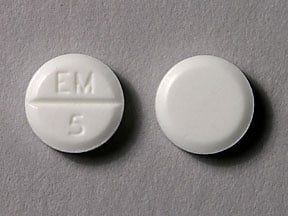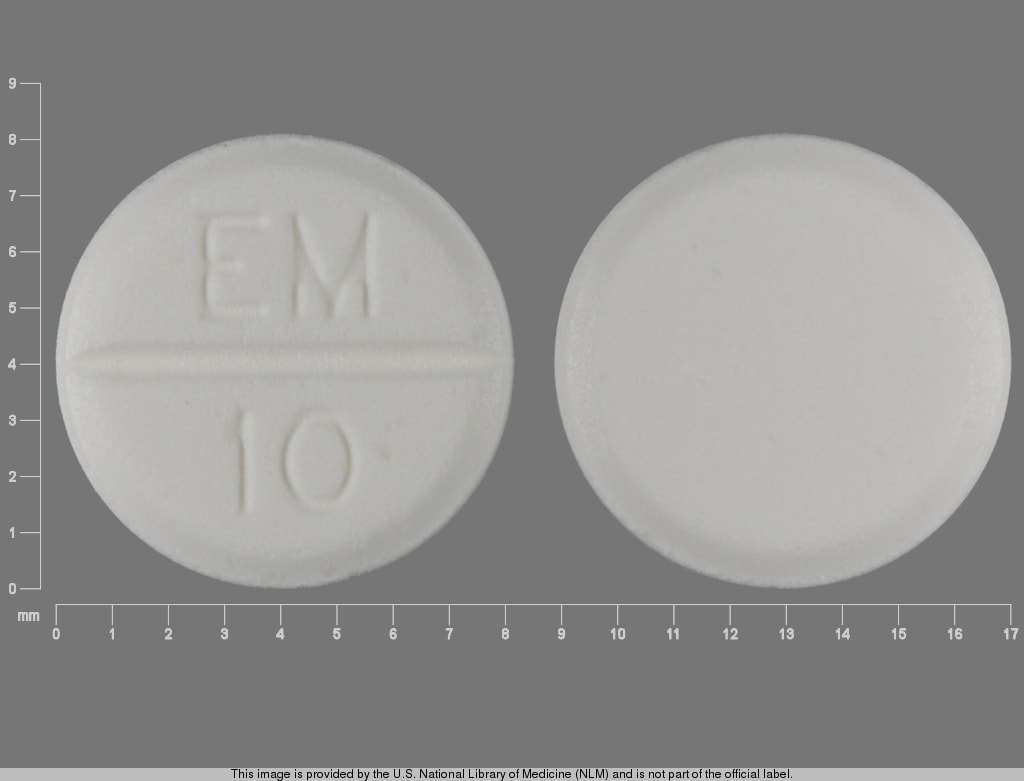Methimazole
Generic name: methimazole
Brand names: Tapazole, Northyx
Dosage form: oral tablet (10 mg; 5 mg)
Drug class: Antithyroid agents
Medically reviewed by A Ras MD.
What is methimazole used for?
Methimazole is a prescription medicine that is used to treat an overactive thyroid gland.
Description
Methimazole (1-methylimidazole-2-thiol) is a white, crystalline substance that is freely soluble in water. It differs chemically from the drugs of the thiouracil series primarily because it has a 5- instead of a 6-membered ring.
Each tablet contains 5 or 10 mg (43.8 or 87.6 µmol) methimazole, an orally administered antithyroid drug.
Each tablet also contains lactose monohydrate, magnesium stearate, potato starch, and talc.
The molecular weight is 114.17, and the molecular formula is C4H6N2S. The structural formula is as follows:
Before taking methimazole, tell your doctor:
- If you are allergic to methimazole; any part of this medicine; or any other drugs, foods, or substances. Tell your doctor about the allergy and what signs you had.
This medicine may interact with other drugs or health problems.
Tell your doctor and pharmacist about all of your drugs (prescription or OTC, natural products, vitamins) and health problems. You must check to make sure that it is safe for you to take methimazole with all of your drugs and health problems. Do not start, stop, or change the dose of any drug without checking with your doctor.
What are some things I need to know or do while I take methimazole?
- Tell all of your health care providers that you take methimazole. This includes your doctors, nurses, pharmacists, and dentists.
- Have blood work checked as you have been told by the doctor. Talk with the doctor.
- Some blood vessel problems have happened with methimazole. Sometimes, this has led to severe health problems like kidney problems, nerve problems, and bleeding in the lungs. If you have questions, talk with the doctor.
- This medicine may cause harm to the unborn baby if you take it while you are pregnant, especially in the first trimester.
- If you are pregnant or you get pregnant while taking methimazole, call your doctor right away.
- Tell your doctor if you are breast-feeding. You will need to talk about any risks to your baby.
- Have your baby’s thyroid checked if you are using methimazole and breast-feeding.
How is methimazole best taken?
Use methimazole as ordered by your doctor. Read all information given to you. Follow all instructions closely.
- Keep taking methimazole as you have been told by your doctor or other health care provider, even if you feel well.
What do I do if I miss a dose?
- Take a missed dose as soon as you think about it.
- If it is close to the time for your next dose, skip the missed dose and go back to your normal time.
- Do not take 2 doses at the same time or extra doses.
What are the side effects of methimazole that I need to call my doctor about immediately?
WARNING/CAUTION: Even though it may be rare, some people may have very bad and sometimes deadly side effects when taking a drug. Tell your doctor or get medical help right away if you have any of the following signs or symptoms that may be related to a very bad side effect:
- Signs of an allergic reaction, like rash; hives; itching; red, swollen, blistered, or peeling skin with or without fever; wheezing; tightness in the chest or throat; trouble breathing, swallowing, or talking; unusual hoarseness; or swelling of the mouth, face, lips, tongue, or throat.
- Signs of liver problems like dark urine, feeling tired, not hungry, upset stomach or stomach pain, light-colored stools, throwing up, or yellow skin or eyes.
- Signs of kidney problems like unable to pass urine, change in how much urine is passed, blood in the urine, or a big weight gain.
- Signs of lupus like a rash on the cheeks or other body parts, sunburn easy, muscle or joint pain, chest pain or shortness of breath, or swelling in the arms or legs.
- Signs of low blood sugar like dizziness, headache, feeling sleepy, feeling weak, shaking, a fast heartbeat, confusion, hunger, or sweating.
- Shortness of breath.
- Coughing up blood.
- Swelling.
- A burning, numbness, or tingling feeling that is not normal.
- Swollen gland.
- Low blood cell counts have happened with methimazole. If blood cell counts get very low, this can lead to bleeding problems, infections, or anemia. Call your doctor right away if you have signs of infection like fever, chills, or sore throat; any unexplained bruising or bleeding; or if you feel very tired or weak.
What are some other side effects of methimazole?
All drugs may cause side effects. However, many people have no side effects or only have minor side effects. Call your doctor or get medical help if any of these side effects or any other side effects bother you or do not go away:
- Itching.
- Change in taste.
- Feeling sleepy.
- Headache.
- Muscle or joint pain.
- Hair loss.
- Upset stomach or throwing up.
- Change in color of skin.
These are not all of the side effects that may occur. If you have questions about side effects, call your doctor. Call your doctor for medical advice about side effects.
You may report side effects to the FDA at 1-800-332-1088. You may also report side effects at https://www.fda.gov/medwatch.
If overdose is suspected:
If you think there has been an overdose, call your poison control center or get medical care right away. Be ready to tell or show what was taken, how much, and when it happened.
How do I store and/or throw out methimazole?
- Store at room temperature.
- Store in a dry place. Do not store in a bathroom.
- Keep all drugs in a safe place. Keep all drugs out of the reach of children and pets.
- Throw away unused or expired drugs. Do not flush down a toilet or pour down a drain unless you are told to do so. Check with your pharmacist if you have questions about the best way to throw out drugs. There may be drug take-back programs in your area.
Consumer information use and disclaimer
- If your symptoms or health problems do not get better or if they become worse, call your doctor.
- Do not share your drugs with others and do not take anyone else’s drugs.
- Some drugs may have another patient information leaflet. Check with your pharmacist. If you have any questions about methimazole, please talk with your doctor, nurse, pharmacist, or other health care provider.
- If you think there has been an overdose, call your poison control center or get medical care right away. Be ready to tell or show what was taken, how much, and when it happened.
This information should not be used to decide whether or not to take methimazole or any other medicine. Only the healthcare provider has the knowledge and training to decide which medicines are right for a specific patient. This information does not endorse any medicine as safe, effective, or approved for treating any patient or health condition. This is only a brief summary of general information about this medicine. It does NOT include all information about the possible uses, directions, warnings, precautions, interactions, adverse effects, or risks that may apply to methimazole. This information is not specific medical advice and does not replace information you receive from the healthcare provider. You must talk with the healthcare provider for complete information about the risks and benefits of using this medicine.
Label
PACKAGE LABEL.PRINCIPAL DISPLAY PANEL
Methimazole Tablets, USP 5 mg – NDC 62135-205-30 – 30 Tablets Label


Methimazole Tablets, USP 10 mg – NDC 62135-206-30 – 30 Tablets Label


SRC: NLM .
